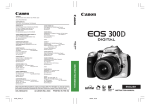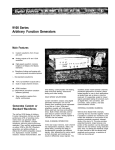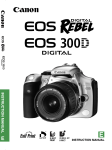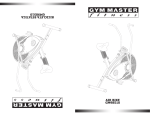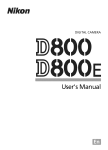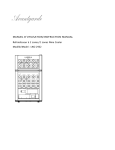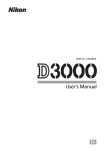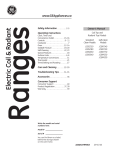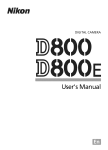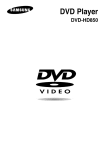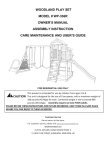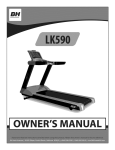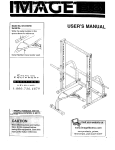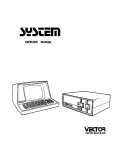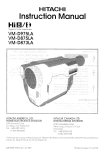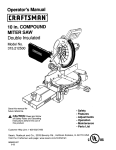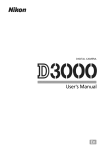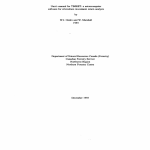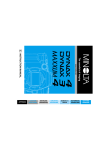Download User`s Manual - Sears PartsDirect
Transcript
DIGITAL CAMERA
)C)
User's Manual
TechnicalNotes
- Camera Care, Options,
This chapter
and Resources
covers the following
Compatible
topics:
Lenses ......................................................... pg. 370
Optional Flash Units (Speedlights) ............................. pg. 377
Other Accessories ........................................................... pg. 385
Caring for the Camera ................................................... pg. 391
Storage ........................................................................................
pg. 391
Cleaning ...........................................................................................
pg. 391
The Low-PassFilter ........................................................................
pg. 392
"Clean Now". .............................................................................
pg. 392
"Clean at Startu p/Shutdown". ............................................
pg. 393
Manual Cleaning .....................................................................
pg. 395
Caring for the Camera and Battery: Cautions ........... pg. 398
Troubleshooting
............................................................. pg. 402
Error Messages ................................................................ pg. 409
Appendix
......................................................................... pg. 417
Specifications
.................................................................. pg. 428
369
CPU lenses (particularly types G and D) are recommended for use
with the D700. CPU lenses can be identified by the presence of
CPU contacts, type G and D lenses by a letter on the lens barrel.
Type G lenses are not equipped with a lens aperture ring.
CPU contacts
Aperture ring
CPU lens
Type G lens
Compatible
CPU Lenses i
1 IX-Nikkor
lenses can not be used.
2 Vibration
Reduction
3 Spot metering
(VR) supported
meters
selected
with
VR lenses.
focus point.
4 Can not be used with shifting or tilting.
5 The camera's exposure metering and flash control
properly when shifting
the maximum
aperture
6 Manual
Type D lens
exposure
and/or tilting
is used.
systems do not work
the lens, or when an aperture
mode only.
7 Can be used with AF-S and AF-I lenses only (pg. 371).
8 With maximum
effective aperture of f/5.6 or faster.
370
other than
9 When
focusing
atminimum
focus
distance
withAF80-200mm
f/2.8,
AF3570mm
f/2.8,
AF28-85mm
f/3.5-4.5
<New>,
orAF28-85mm
f/3.5-4.5
lens
at
maximum
zoom,
in-focus
indicator
may
bedisplayed
when
image
onmatte
screen
inviewfinder
isnotinfocus.
Adjust
focus
manually
untilimage
in
viewfinder
isinfocus.
10With
maximum
aperture
off/5.6
orfaster.
[]
The AF-S/AF-I
Teleconverter
The AF-S/AF-I teleconverter
lenses:
can be used with the following
• AF-S VR Micro 105mm f/2.8G ED 1
• AF-S VR 200mm f/2G ED
• AF-S VR 300mm f/2.8G ED
•
•
•
•
•
•
AF-S 300mm f/2.8D ED II
AF-S 300mm f/2.8D ED
AF-1300mm f/2.8D ED
AF-S 300mm f/4D ED 2
AF-S NIKKOR 400mm f/2.8G ED VR
AF-S 400mm f/2.8D ED II
• AF-S 400mm f/2.8D ED
• AF-1400mm f/2.8D ED
AF-S and AF-I
•
•
•
•
AF-S NIKKOR 500mm f/4G ED VR 2
AF-S 500mm f/4D ED II 2
AF-S 500mm f/4D ED 2
AF-1500mm f/4D ED 2
•
•
•
•
•
AF-S NIKKOR 600mm f/4G ED VR 2
AF-S 600mm f/4D ED II 2
AF-S 600mm f/4D ED 2
AF-1600mm f/4D ED 2
AF-S VR 70-200mm f/2.8G ED
• AF-S 80-200mm f/2.8D ED
• AF-S VR 200-400mm f/4G ED2
1 Autofocus not supported.
2 Autofocus not supported when used with AF-STeleconverter TC-17E II/TC-20E II.
[]
Lens f-number
The f-number
given in lens names is the maximum
aperture
of the lens.
371
Non-CPU
Lenses 1
Non-CPU lenses include manual focus lenses and other lenses
without a built-in CPU. The following
CPU lenses and accessories.
J
SC ]
Lens/accessory
non-
Focusmode
,
I Metering system
M (with
electronic
'
_:
i
_
i
I A /_]D_Tl_Colo_r:[E-_
....
AI-, AI-modified,
Nikon
is a list of compatible
Nikkor
rangefinder)
or
-!
Series E lenses _
MedicaI-Nikkor
120ram
--
f/4
_
v,
--
Reflex-Nikkor
PC-Nikkor
AI-type
Teleconverter
_0
PB-6 Bellows Focusing
Attachment
_
-I
Auto extension
rings (PKseries 11A, 12, or 13; PN-11)
1 Some
lenses
-I
can not be used
_11
(pg. 373).
2 Range of rotation
for AI 80-200ram
body. Filters can not be exchanged
camera.
3 With
maximum
4 If maximum
aperture
aperture
f/2.8 ED tripod mount
while AI 200-400ram
of f/5.6 or faster.
is specified
using Non-CPU
value will be displayed in viewfinder
5 Can be used only if lens focal length
Non-CPU lens data (pg. 210).
results are not achieved.
6 For improved
precision,
specify
exposure
mode,
lens data (pg. 210), aperture
and control panel.
and maximum
aperture
are specified
Use spot or center-weighted
lens focal length
Non-CPU lens data (pg. 210).
7 Can be used in manual exposure
8 Electronic rangefinder
9 Exposure determined
is limited by camera
f/4 ED is mounted
on
metering
and maximum
modes at shutter
speeds
using lens aperture
ring before
I0 Exposure compensation
required when used with A128-85mm
105mm f/3.5-4.5,
AI 35-I 35mm f/3.5-4.5, or AF-S 80-200mm
teleconverter
manual for details.
11 With
maximum
effective
aperture
of f/5.6 or faster.
using
slower than 1/12s s.
lock or shifting lens. In manual exposure mode, preset aperture
aperture ring and determine
exposure before shifting lens.
372
aperture
can not be used with shifting or tilting.
by presetting
lens aperture.
In aperture-priority
preset aperture
using
if desired
auto
performing
AE
using lens
f/3.5_.5,
A135f/2.8D. See
12Requires
PK-12
orPK-13
auto
extension
ring.PB-6D
may
berequired
depending
oncamera
orientation.
13Use
preset
aperture.
Inaperture-priority
auto
exposure
mode,
setaperture
using
focusing
attachment
before
determining
exposure
andtaking
photograph.
•PF-4
Reprocopy
Outfit
requires
PA-4
Camera
Holder.
[]
Compatible
Non-CPU
Lenses
If lens data are specified using Non-CPU lens data (pg. 210), many of the
features available with CPU lenses can also be used with non-CPU lenses.
If lens data are not specified,
center-weighted
metering
color matrix metering
is used when
can not be used, and
matrix metering
is selected.
Non-CPU lenses can only be used in exposure modes Ft and !I, when
aperture must be set using the lens aperture ring. If the maximum
aperture
has not been specified
aperture
display will show the number
the actual aperture
using Non-CPU
lens data, the camera
of stops from maximum
value must be read offthe
lens aperture
aperture;
ring.
Aperture-priority
auto will be selected automatically
in exposure modes P
and ,5. The exposure-mode
indicator (P or ,5) in the control panel will
blink, and Ft will be displayed
Incompatible
The following
in the viewfinden
Accessories and Non-CPU
accessories and non-CPU
Lenses
lenses can NOTbe used with the
D700:
• TC-16AS
• Non-AI
AF teleconverter
• Lenses that
focusing
• Fisheye
f/2.8,
require
unit
f/5.6, 800mm
8mm
• AF lenses for the
lenses
f/4.5, 600mm
f/8, 1200mm
(6mm
f/5.6,
f/8, OP 10mm
AF Teleconverter
the AU-1
(400mm
f/11)
7.5mm
f/5.6,
f/5.6)
• PC 28mm
Ring
• 180-600mm
K2
f/8 ED (serial
numbers
174041-174180)
• 360-1200mm
f/4 (serial
number
180900
• PC 35mm
f/2.8
(serial numbers
f/3.5
(old type)
• Reflex
1000mm
f/6.3
(old type)
• Reflex
1000mm
f/11
(serial numbers
f/11
(serial numbers
142361-143000)
f/11 ED (serial
174031-174127)
• 200-600mm
ED,
TC-16)
or earlier)
• PC 35mm
• Extension
F3AF (AF 80mm
f/3.5
851001-906200)
• 2.1 cm f/4
numbers
AF 200mm
f/9.5
• Reflex 2000mm
200111-200310)
(serial numbers
280001-300490)
373
[]
The Built-in Flash
The built-in
flash can be used with CPU lenses with focal lengths of 24 mm
(16 mm in DX format) to 300ram.
The flash has a minimum
Remove lens hoods to prevent shadows.
range of 60 cm (2 ft.) and can not be used in the
macro range of macro zoom lenses. The flash may be unable to light the
entire subject with the following
below:
:"
Lens
AF-S DX 12-24mm
AF-S DX 17-55mm
AF-S 17-35mm
AF 18-35mm
lenses at ranges less than those given
f/4G ED
=Zoo--m-posi_tio_°°n
..........._Mi_°
n_r_an_°g_'e
-°°_
18mm
0.6 m/2 ft.
f/2.8G ED
f/2.8D ED
f/3.5-4.SD ED
AF 20-35mm
f/2.8D
PC-E NIKKOR 24ram f/3.SD ED
AF-S NIKKOR 24-70mm
AF-S VR 24-120mm
AF-S 28-70mm
f/2.8G ED
20mm
1.5 m/4 ft. 11 in.
28ram
1.0 m/3 ft.
3m.
24ram
1.0 m/3 ft.
3m.
24 mm
1.0 m/3 ft.
3 in.
24 mm
1.5 m/4 ft. 11 in.
35 mm
1.0 m/3 ft.
3 in.
f/3.5-5.6G ED
24ram
1.0 m/3 ft.
3m.
f/2.8D ED
35 mm
1.5 m/4 ft. 11 in.
When used with the AF-S NIKKOR 14-24mm
f/2.SO ED, the flash will be
unable to light the entire subject at all ranges.
The built-in
flash can also be used with AI-, Al-modified
Nikkor, Nikon
Series Eand non-CPU lenses with a focal length of24-300mm.
300ram f/4.5, modified AI 50-300ram f/4.5, and AI-S 50-300ram
AI 50f/4.5 ED
lenses must be used at a zoom position of 180ram or above, and AI 50300ram f/4.5 ED lenses at a zoom position of 135mm or above.
¢
374
_I_ Red-Eye Reduction
Lenses that block the subject's view of the AF-assist illuminator
interfere with
may
red-eye reduction.
_I_ AF-Assist Illumination
The AF-assist illuminator
can be used with lenses with focal lengths of 24-
200 mm. AF-assist illumination
• AF-S VR 200mm f/2G ED
is not available with the following lenses:
• AF-S VR 200-400mm f/4G ED
At ranges under 0.7 m (2ft. 4in.), the following
lenses may block the AF-
assist illuminator and interfere with autofocus when lighting is poor:
• AF Micro 200mm f/4D ED
• AF-S DX 17-55mm f/2.8G ED
• AF-S VR 24-120mm f/3.5-5.6G ED
• AF-S NIKKOR 24-70mm f/2.8G ED
• AF Micro 70-180mm f/4.5-5.6D
• AF-S 17-35mm f/2.8D ED
At ranges under
ED
• AF-S 28-70mm
1.1 m (3ft. 7 in.), the following
assist illuminator and interfere with autofocus
• AF-S DX VR 55-200mm f/4-5.6G ED
At ranges under
1.5 m (4ft. 11 in.), the following
f/2.8D ED
lenses may block the AFwhen
lighting
is poor:
lenses may block the AF-
assist illuminator and interfere with autofocus when lighting is poor:
• AF-S VR 70-200mm f/2.8G ED
• AF-S VR 70-300mm f/4.5-5.6G ED
• AF-S 80-200mm f/2.8D ED
• AF-S NIKKOR 14-24mm f/2.8G ED
• AF 80-200mm
f/2.8D ED
At ranges under 2.3 m (7ft. 7 in.), the following
lenses may block the AF-
assist illuminator and interfere with autofocus
• AF VR 80-400mm f/4.5-5.6D ED
when
lighting
is poor:
375
[]
Calculating
Picture
Angle
The D700 can be used with Nikon
lenses for 35mm
If Auto DX crop is on (the default setting)
attached,
(135) format
and a 35mm format
cameras.
lens is
the picture angle will be the same as a frame of 35mm film
(36.0 x 23.9 mm); ifa DX lens is attached,
automatically
be adjusted
the picture angle will
to 23.5 x 15.6 mm (DX format).
To choose a picture angle different
from that of the current
DX crop off and select FX format
(36 x 24) or DX format
35 mm format
lens is attached,
1.5 x by selecting
DX format
lens, turn Auto
(24 x 16). If a
the picture angle could be reduced by
(24 x 16), exposing
FX format
a smaller area.
(36 x 24) picture
equivalent
size (36.0 × 23.9 mm,
to 35mm
format
camera)
/
//
Lens
Picture
DX format (24 x 16) picture size
(23.5 × 15.6 mm, equivalent to DX
/
/
,/
\
format_ m_!_!
Picture angle (FX format (36 x 24);
35mm format)
!
Picture angle (D× format
The DX format
diagonal
(24 x 16) picture angle is about
35mm format
picture angle. To calculate
35mm format
when DX format
(24 x 16); DX format)
1.5 times smaller than the
the focal length of lenses in
(24 x 16) is selected, multiply
the focal
length of the lens by about 1.5 (for example, the effective focal length of a
50mm lens in 35mm format would be 75 mm when DX format (24 x 16)
is selected).
376
The D700 can be used with CLS-compatible
flash units. Remove the accessory shoe cover
when attaching optional flash units. The
built-in flash will not fire when an optional
flash unit is attached.
The Nikon Creative
Lighting
System
(CLS)
Nikon's advanced Creative Lighting System (CLS) offers improved
communication
between the camera and compatible flash units
for improved flash photography.
The Creative Lighting System
supports the following features:
• i-TTLflashcontrol:Improved through-the-lens
(TTL) flash control
for use with CLS (see page 184). Flash level is set using monitor
pre-flashes to measure the light reflected by the subject,
ensuring optimal flash output.
• AdvancedWirelessLighting:Allows i-TTL flash control with remote
wireless flash units.
• FVlock (pg. 192): Locks flash level at the metered value, allowing a
series of photographs to be taken at the same flash level.
• AutoFPHigh-SpeedSync(pg. 306): Allows the flash to be used at the
highest shutter speed supported by the camera, making it
possible to choose the maximum aperture for reduced depth of
field.
377
II CLS-CompatibleFlashUnits
The DTO0 can be used with the following CLS-compatible flash
units: the SB-900, SB-800, SB-600, SB-400, SB-R200, and SU-800.
The SB-900, SB-800, SB-600, SB-400, and SB-R200
The principal
features of these flash units are listed below.
.....°4
Feature .......................
_
SB-900 !
SB-800
SB-600
SB-400
38/125
30/9--_
21/6_
10/32
..............
53/I 75
____42/I38
30/9_
14/49
24-I
24-85
__ 4
__ 5
_
Guide No.
Auto power zoom (mm)
17-200
Wide panel (mm)
12,14,17
Head rotation
14,17
7 o down,
7 odown,
90 ° up,
180 ° left
90 ° up,
180 ° left,
and right
I Ifa color filter is attached
balance,
05
90 ° right
to the SB-900 when
the camera will automatically
detect
14
SB-R200 2
m
m
60 o down
90 ° up,
180 ° left, 90 ° up
90 ° right
(toward
lens
light axis),45
o
u p (away from
light
AUTOor _ (flash) is selected
the filter and adjust white
axis)
for white
balance
appropriately.
2 Controlled
remotely with built-in flash in commander
mode or using optional
SB-900, SB-800 flash unit or SU-800 wireless Speedlight
commander.
3 m/ft., 20 °C (68 °F); SB-900, SB-800 and SB-600 at 35 mm zoom
SB-900 with standard illumination.
head position;
4 27 mm zoom coverage.
5 24 mm zoom coverage.
SU-800 Wireless Speedlight Commander
When mounted on a CLS-compatible camera, the SU-800 can be
used as a commander for remote SB-900, SB-800, SB-600, or
SB-R200 flash units. The SU-800 itself is not equipped
378
with a flash.
[]
Guide Number
To calculate
the range of the flash at full power, divide the Guide Number
by the aperture.
For example,
at ISO I00 the SB-800 has a Guide Number
of 38 m or 125 ft. (35 mm zoom head position);
f/5.6 is 38+5.6
its range atan aperture
of
or about 6.8 meters (or in feet, 125+5.6 =approximately
23 ft. 7 in.). For each twofold increase in ISO sensitivity, multiply
Number by the square root of two (approximately
1.4).
the Guide
379
The following features are available with the SB-900, SB-800,
SB-600, SB-400, SB-R200, and SU-800:
Flash unit
I Commander
Remote
sB oo
Flash mode
!
sB-8oo
i-TTL
i-TTLbalancedfill-flash
for digital SLR
AA
Auto aperture
A
Non-TTLauto
,v '2
GN
Distance-prioritymanual
v'
M
Manual
RPT
Repeating flash
B , oo
v'
v'
Auto FPH igh-SpeedSync7
FVlock
AF-assistfor multi-area AF8
FlashColorInformation
v'
Communication
R_/
Rear-curtain
sync
Red-eye
reduction
Autozoom
1 Only available
when
2 Standard
i-IlL flash
with flash unit.
SU-800
for digital
is used
to control
SLR is used
with
other
flash
units.
spot metering
or when
selected
3 Standard i-TTL flash for digital SLR is used with spot metering.
4 Selected with flash unit. Non-TTL auto (A) selected automatically
if non-CPU
is attached without specifying
lens data using Non-CPU lens data.
lens
Auto aperture (AA) is used regardless of mode selected with flash unit. Non-TTL
auto (A) selected automatically
if non-CPU lens is attached without specifying
lens data using Non-CPU
6 Selected with flash unit.
7 Select 1/320s
(Auto FP) or 1/250s
speed, pg. 305).
CPU lens required.
380
lens data.
(Auto FP) for Custom
Setting
el
(Flash sync
Other
Flash
Units
The following flash units can be used in non-TTL auto and manual
modes. If they are set to TTL, the camera shutter-release button
will lock and no photographs can be taken.
_-s°i3_80D°X._ '
A
Non-TTL
M
Manual
auto
Repeating
REAR Rear-curtain
flash
sync
SB-30,SB-27 !,
SB22S'SB22'
SB-20,
5B-16B, SB45
SB,21B2,
SB.29S2
v'
--
V'
--
v'
v'
v'
v'
v'
--
--
--
v'
v'
v'
I Flash mode is automatically
set to TTL and shutter-release
unit to A (non-TTL auto flash).
2 Autofocus
is only available
with
AF-Micro
is disabled.
v'
Set flash
lenses (60 mm, 105 mm, or 200 mm).
381
[I_ Notes on Optional
Speedlights
Refer to the Speedlight
manual
supports
for detailed
the Nikon Creative Lighting
compatible
digital SLR cameras.
SLR" category
instructions.
If the Speedlight
System, refer to the section on CLS-
The D700 is not included
in the "digital
in the SB-80DX, SB-28DX, and SB-50DX manuals.
i-TTL flash control can be used at ISO sensitivities
between
200 and 6400.
At values over 6400, the desired results may not be achieved at some
ranges or aperture settings.
If the flash-ready indicator blinks for about
three seconds after a photograph
and the photograph
is taken, the flash has fired at full power
may be underexposed.
The SB-900, SB-800, SB-600, and SB-400 provide
red-eye
the SB-900, SB-800, SB-600, and SU-800 provide
AF-assist illumination.
With other Speedlights,
the camera AF-assist illuminator
reduction,
while
is used for AF-
assist illumination
and red-eye reduction. When used with AF lenses with
focal lengths of 17-135 mm, the SB-900 provides active AF-assist
illumination
for all focus points;
only with the following
17.i9 mm
ooooooooo
............
ooo ooo
ooo
ooo
note, however,
20-105 mm
ooo
ooo
oooo ooo
...........
oooo ooo
ooo
ooo
When used with AF lenses with focal lengths
SB-600, and SU-800 provides
autofocus
for the following
24-- 34ram
o
o
..............
...........
o
o
o
o
In programmed
o
o
.....
_==_'
oooo
oooo
ooo
o
of 24-105
mm, the SB-800,
to assist
focus points:
35- 49ram
to sensitivity
o
o .......
...........
50_105mm
o
o o
o
o o
o
o
o
o
aperture
o
o
(minimum
(ISO equivalency),
is
below:
Maximumapertureat ISOequivalent of:
For each one-step
382
o
..........
f-number)
as shown
increase in sensitivity
(e.g., from 200 to 400), aperture
stopped down by half an f-stop.
If the maximum aperture
smaller than given above, the maximum value for aperture
maximum
is available
106_135 mm ...........
active AF-assist illumination
auto, the maximum
limited according
that autofocus
focus points:
aperture
of the lens.
of the lens is
will be the
is
When an SC-series 17, 28, or 29 sync cable is used for off-camera flash
photography,
correct exposure may not be achieved in i-TTL mode.
We
recommend that you choose spot metering to select standard
control.
Take a test shot and view the results in the monitor.
In i-TTL, use the flash panel or bounce
adapter
unit. Do not use other panels such as diffusion
produce incorrect exposure.
provided
i-TTL flash
with the flash
panels, as this may
_I_ Use Only Nikon Flash Accessories
Use only Nikon Speedlights.
Negative
voltages
or voltages over 250 V
applied to the accessory shoe could not only prevent normal operation,
but damage the sync circuitry of the camera or flash. Before using a
Nikon Speedlight
not listed in this section, contact
service representative
a Nikon-authorized
for more information.
383
Flash Contacts
The D700 is equipped with an accessory shoe for attaching
optional flash units directly to the camera and a sync terminal
allows flash units to be connected via a sync cable.
that
II TheAccessoryShoe
Use the accessory shoe to mount optional
flash units directly on the camera without a
sync cable (pg. 378). The accessory shoe is
equipped with a safety lock for Speedlights
with a locking pin, such as the SB-900, SB-800,
SB-600 and SB-400.
II TheSyncTerminal
A sync cable can be connected to the sync
terminal as required. Do not connect
another flash unit via a sync cable when
performing rear-curtain sync flash
photography with a flash unit mounted on
the camera accessory shoe.
[I_ ISO Sensitivity
When auto ISOsensitivity control is on (pg. 108), ISOsensitivity will
_
automatically be adjusted as required for optimal flash output when an
optional SB-900, SB-800,SB-600, or SB-400 flash unit is attached. This may
result in foreground subjects being underexposed in photographs taken
with the flash at slow shutter speeds, in daylight, or against a bright
background. In these cases,choose a flash mode other than slow sync or
choose a larger aperture.
384
Atthetimeofwriting,thefollowingaccessories
wereavailable
for
theD700.
• RecharcjeableLi-ion Battery EN-EL3e(pp. 32, 34): Additional
EN-EL3e batteries are available from Ioca retailers and
Nikon service representatives.
The EN-EL3e can be
recharged using an MH-18a or MH-18 quick charger.
• Multi-PowerBattery PackMB-DIO:The MB-DIO takes one
rechargeable
Nikon
EN-EL3e, EN-EL4a, or EN-EL4 Li-ion
battery or eight AA alkaline,
manganese
Powersources
batteries.
NiMH, lithium, or nickel-
A BL-3 battery-chamber
cover is
required when using EN-EL4a or EN-EL4 batteries. It is
equipped with a shutter-release
button, AF-ONbutton,
multi selector, and main-and sub-command
dials for
improved operation
when taking
photographs
in portrait
(tall) orientation.
When attaching the MB-DIO, remove
contact cover for the MB-DIO from the camera.
• QuickChargerMH-18a (pg. 32): The MH-18a can be used to
recharge EN-EL3e battery.
• ACAdapterEH-Sa/EH-5:
These AC adapters
can be used to
power the camera for extended periods.
• WirelessTransrnitterWT-4:Connects the camera to wireless
and Ethernet
networks.
The photographs
memory
card can be viewed
by computers
network
or co pied to a computer
WirelessLAN
The camera can also be controlled
adapters
the network
separately).
on the camera
on the same
for long-term storage.
from any computer
on
using Camera Control Pro 2 (available
Note that the WT-4 requires an independent
power source; an EH-6 AC adapter
battery is recommended
details.
or a second EN-EL3e
See the WT-4 manual
for
385
DK-17CDiopter-AdjustmentViewfinderLenses(with Safety Lock):To
accommodate
individual differences in vision, viewfinder
lenses are available
Use diopter
with diopters
adjustment
of -3, -2, O, +1, +2 m 1.
lenses only if the desired focus
can not be achieved with the built-in diopter adjustment
control (-3 to +1 m 1). Test diopter adjustment
lenses
i
i
iiI _
i
_
before purchase
achieved.
i
i
to ensure that the desired focus can be
Magnifying EyepieceDK-17M(with Safety Lock):The DK-17M
magnifies the view through the viewfinder by
approximately
1.2 x for greater precision when framing.
iiiiiii iiiiii :.
Magnifier DG-2:The DG-2 magnifies
the scene displayed
in
the viewfinden
Use for close-up photography,
copying,
telephoto
lenses, and other tasks that call for added
precision.
required.
Viewfinder
eyepiece
accessories
•
DK-18 eyepiece adapter
(available
separately)
EyepieceAdapterDK-18:The DK-18 is used when attaching
the DG-2 magnifier or DR-3 right-angle
attachment
to the D700.
viewing
Antifog FinderEyepieceDE-14,DK-17A:These viewfinder
eyepieces
prevent fogging
The DK-17A is equipped
ii
iii
RubberEyepieceCupDE-19:The DK-19 makes the image in the
i_
iiiii!i
iiiiiii
iiiiiiili
viewfinder easier to see, preventing eye fatigue.
Right-AngleViewingAttachmentDR-S/DR-4:The DR-5 and DR-4
attach to the viewfinder
allowing
ii
in humid or cold conditions.
with a safety lock.
i
eyepiece at a right angle,
the image in the viewflnder
position. The DR-5 can also magnify
ii
ii
i ii ii ii ii ii
386
shooting
the view through
the
viewfinder by 2 x for greater precision when framing
(note that the edges of the frame will not be visible when
the view is magnified).
×
to be viewed from
above when the camera is in the horizontal
_-_!_-•
Nikon filters can be divided
into three types: screw-in,
slip-in, and rear-interchange.
Use Nikon filters; filters
manufactured
by other makers may interfere
with
autofocus or electronic range finding.
• The D700 can not be used with linear polarizing
filters.
Use the C-PL circular polarizing filter instead.
• The NC and L37C filters are recommended
for protecting
Filters
the lens.
• To prevent moire, use of a filter is not recommended
when the subject is framed against a bright light, or when
a bright
light source is in the frame.
• Center-weighted
metering
is recommended
with filters
with exposure factors (filter factors) over 1 x (Y44, Y48,
Y52, 056, R60, X0, Xl, C-PL, ND2S, ND4, ND4S, ND8, ND8S,
ND400, A2, A12, B2, B8, B12).
_-_--_ii_!
WaterGuardWG-AS3:Covers the base of the optional SB-900
Water guards flash unit to protect the camera accessory shoe from water
droplets.
• NikonSpeedlightsSB-900,SB-800,SB-600,andSB-400
Optionalflash • NikonWirelessRemoteSpeedlightSB-R200
units
• WirelessSpeedlightCommanderSU-800
See page 378 for more information.
Petard
adapters
• PCCardAdapterEC-ADI:The EC-AD1 PC card adapter
Type l CompactFlash
PCMCIA card slots.
memory
cards to be inserted
allows
in
387
_=_7_i_"°_-_'_
• CaptureNX2: A complete photo editing package.
• CameraControlPro2: Control the camera remotely from a
computer and save photographs
hard disk.
Software
directly to the computer
• Image Authentication: Determine whether photographs
taken with image authentication
(pg. 342) on have been
modified
after shooting.
Note: Use the latest versions of Nikon software. Most Nikon
software offers an auto update feature when the computer is
connected to the Internet.
Bodycap
• BodyCap:The body cap keeps the mirror, viewfinder
screen, and low-pass filter free of dust when a lens is not
in place.
388
The
D700
is equipped
with
a ten-
pin remote
terminal
for remote
control
and automatic
Remote
terminal
acce S Sories
photography.
The terminal
is
.....
proviclecl
with a cap, wnicn
protects
.
.
the contacts
when the terminal
is
not in use.
The following
accessories
can
be used (all lengths
="=A_c_c_es_sor_
,=!= '_:_°°°_°°_
_°'_
Remote
Cord
MC-22
Remote Cord
MC-30
Remote Cord
MC-36
remote
shutter-triggering
control
via sound
Remote
shutter
reduce
open
during
Modulite
signals.
a time
release;
can be used for
camera
shake or keep the shutter
photography
or to reduce
open
exposure.
Equipped
panel,
shutter-release
control
photography,
at one-second
Can be connected
two
85 cm
with
lock
and timer
that
to ML-3
or MC-series
cameras
20,
can
for simultaneous
40 cm
(1 ft. 4 in.)
to two-pin
connection
control
3m
(9 ft. 10 in.)
operation.
terminals,
(2 ft. 9in.)
intervals.
22, 23, 25, 30, or 36. Only one MC-21
be used at a time.
Connects
(2 ft. 7 in.)
exposure.
timer
a time
80 cm
shake or keep the shutter
interval
during
1 m
(3 ft. 3 in.)
allowing
can be used to
shutter
Ten-pin
GPS Adapter Cord
MC-35
or electronic
Remote
beeps
Adapter Cord
MC-25
device,
release;
camera
back-lit
Connecting
Cord
MC-23
_°_=[engt°il
_
Remote shutter release with blue, yellow,
and black terminals
for connection
to a
for use in bulb
Extension Cord
MC-21
are approximate):
Descriptio
n
adapter
to devices
including
with
cord
the MW-2
set, MT-2 intervalometer,
modulite
control
Connects
GPS devices
for
two-pin
20 cm
radio
and ML-2
(8 in.)
set.
to D700 via PC cable
supplied
by manufacturer
(pg. 213).
Remote
Allows
infrared
Control Set ML-3
upto8
m (26 ft.).
remote
35 cm
of GPS device
(14 in.)
control
at ranges
of
389
II Approved Memory Cards
The following Type I CompactFlash memory
tested and approved for use in the D700:
SanDisk
Extreme
IV
SDCFX4
Extreme
III
SDCFX3
Ultra
II
Professional
Lexar Media Platinum
UDMA
II
Professional
cards, please contact
390
8 GB, 4 GB, 2 GB, 1 GB
SDCFB
4 GB, 2 GB, 1 GB
300 ×
8 GB, 4 GB, 2 GB
80×
2GB,
60 ×
1GB, 512 MB
4 GB
133 × WA
Other cards have not been tested.
×
8 GB, 4 GB, 2 GB
SDCFH
Standard
cards have been
8 GB, 4 GB, 2 GB, 1 GB
For more details on the above
the manufacturer.
Storage
When the camera will not be used for an extended
period, replace
the monitor cover, remove the battery, and store the battery in a
cool, dry area with the terminal cover in place. To prevent mold or
mildew, store the camera in a dry, well-ventilated
area. Do not
store your camera with naphtha or camphor moth balls or in
locations that:
• are poorly ventilated or subject to humidities of over 60%
• are next to equipment that produces strong electromagnetic
fields, such as televisions or radios
• are exposed to temperatures above 50 °C (122 °F) or below
-10°C (14 °F)
Cleaning
_-_,
_:=_= _
...........
soft, dry cloth.
Camera
body
After using the camera atthe
beach or seaside,
wipe off sand or salt with a cloth lightly dampened in distilled
water and dry thoroughly.
Important: Dust or otherforeign
matter inside the camera may cause damage not covered under
warranty.
_=_!:_"
:! C=_U_lass
Lens,
elementsare easii_aa__
lint with a blower.
mirr0r,and vertical
If using an aerosol blower,
to prevent the discharge
of liquid.
keep the can
To remove
viewfinder fingerprints
and other stains, apply a small amount
cleaner to a soft cloth and clean with care.
M
.
onltor
of lens
flngerpr nts and other stans wipe the surface lightly with a
......
'
sort cloth or chamois leather. Do not apply pressure, as this
could result in damage or malfunction.
Do not use alcohol
thinner, or other volatile chemicals.
391
The Low-Pass
Filter
The image sensor that acts as the camera's picture element
is fitted
with a low-pass filter to prevent moire. If you suspect that dirt or
dust on the filter is appearing in photographs, you can clean the
filter using the Clean image sensor option in the setup menu.
The filter can be cleaned at any time using the Clean now option,
or cleaning can be performed automatically
when the camera is
turned on or off.
II "CleanNow"
1
Place the camera base down.
Image sensor cleaning is most effective
when the camera is placed base down as
shown at right.
2
Display the Clean image
sensor menu.
Highlight Clean image sensor
in the setup menu and press I_.
_I_ Image Dust Off
The Image Dust Off option in Capture NX 2 can not use dust off reference
data recorded before image sensor cleaning is performed to retouch
photographs
taken after image sensor cleaning
intend to use Image Dust Offwith
sensor cleaning is performed,
reference data after cleaning
[]
photographs
is performed.
recorded
If you
after image
we recommend
that you record dust off
the image sensor.
Image Sensor Cleaning
If the options
described
in this section are not sufficient
to remove dust or
other foreign objects from the image sensor, clean the sensor manually
described on page 395.
392
as
3
Select Clean now.
Highlight Clean now and press
I_. The message shown at right
will be displayed while
cleaning is in progress.
The message shown at right
will be displayed when cleaning
complete.
@
is
II "Cleanat Startup/Shutdown"
1
Select Clean at startup/
shutdown.
Display the Clean image
sensor menu as described
in
Step 2 on the previous page.
Highlight Clean at startup/
shutdown and press I_.
@
@
393
2
Select an option.
Highlight one of the following
options and press 0.
-_T_--:-Option-°_'T'; _:!
....
Description
L_ON Clean at startup
The image sensor is automatically
cleaned
each time the camera is turned on.
Clean at
L_DFFshutdown
The image sensor is automatically
cleaned
during shutdown each time the camera is
turned off.
L_oO
_ Clean at startup
& shutdown
The image sensor is cleaned automatically
startup and at shutdown.
Cleaning
(default)
off
Automatic
image sensor cleaning
at
off.
_I_ Image Sensor Cleaning
The following
interrupt
image sensor cleaning:
pressing the shutter-release,
depth-of-field
raising the built-in
flash,
preview, or AF-ONbutton,
or
using FV lock.
Cleaning
is performed
fully removed
by vibrating
using the options
the image sensor manually
representative.
If image sensor cleaning
sensor cleaning
internal
394
circuitry.
the image sensor.
(pg. 395) or consult a Nikon-authorized
is performed
may be temporarily
Cleaning
If dust can not be
in the Clean image sensor menu, clean
several times in succession,
disabled to protect
can be performed
service
image
the camera's
again after a short wait.
II Manual Cleaning
If foreign matter can not be removed from the low-pass filter using
the Clean image sensor (pg. 392) option in the setup menu, the
filter can be cleaned manually as described below. Note, however,
that the filter is extremely delicate and easily damaged. Nikon
recommends that the filter be cleaned only by Nikon-authorized
service personnel.
1
Charge the battery
or connect
an AC adapter.
A reliable power source is required when inspecting or
cleaning the low-pass filter. If the battery level is below c_]
(60 %), turn the camera off and insert a fully-charged
EN-EL3e
battery or connect an optional EH-Sa or EH-5 AC adapter.
2
Select Lock mirror up for cleaning.
Remove the lens and turn the camera on.
Highlight Lock mirror up for cleaning
in the setup menu and press I_ (note
that this option is not available at battery
levels of _ or below).
3
Press _.
The message shown at right will be
displayed in the monitor and a row of
dashes will appear in the control panel
and viewfinder. To restore normal
operation without inspecting the lowpass filter, turn the camera off.
395
4
Raise the mirror.
Press the shutter-release
/
I_
I \
button all the way down.
The mirror will be raised and
the shutter curtain will open,
revealing the low-pass filter. The display in the viewfinder will
turn offand the row of dashes in the control panel will blink.
S
Examine the low-pass filter.
Holding the camera so that light falls on
the low-pass filter, examine the filter for
dust or lint. If no foreign objects are
present, proceed to Step 7.
6
Clean thefilter.
Remove any dust and lint from the filter
with a blower. Do not use a blowerbrush, as the bristles could damage the
filter. Dirt that can not be removed with
a blower can only be removed by Nikonauthorized service personnel. Under no circumstances
you touch or wipe the filter.
7
should
Turn the camera off.
The mirror will return to the down position and the shutter
curtain will close. Replace the lens or body cap.
396
i_
Use a Reliable
The shutter
off while
Power Source
curtain
is delicate and easily damaged.
the mirror is raised, the curtain
prevent
damage to the curtain,
If the camera powers
will close automatically.
observe the following
• Do not turn the camera off or remove or disconnect
while the mirror is raised.
• If the battery
To
precautions:
the power source
runs low while the mirror is raised, a beep will sound and
the self-timer
lamp will blink to warn that the shutter
curtain will close
and the mirror will be lowered after about two minutes.
End cleaning
or
inspection immediately.
1_
Foreign
Matter
on the Low-Pass Filter
Nikon takes every possible precaution to prevent foreign matter from
coming into contact with the low-pass filter during production
and
shipping.
The D700, however, is designed
interchangeable
lenses, and foreign
lenses are removed
or exchanged.
to be used with
matter
may enter the camera when
Once inside the camera, this foreign
matter may adhere to the low-pass filter, where it may appear in
photographs
taken under certain conditions.
To protect the camera when
no lens is in place, be sure to replace the body cap provided
with the
camera, being careful to first remove all dust and other foreign
may be adhering
Should foreign
as described
personnel.
matter that
to the body cap.
matter find its way onto the low-pass
above, or have the filter cleaned
Photographs
affected
filter, clean the filter
by authorized
by the presence
of foreign
Nikon service
matter
on the
filter can be retouched using Capture NX 2 (available separately; pg. 388)
or the clean image options available in some third-party imaging
applications.
Servicing
the Camera
The camera is a precision
recommends
and Accessories
device and requires regular servicing.
that the camera be inspected
Nikon service representative
by the original
Nikon
retailer or
once every one to two years, and that it be
serviced once every three to five years (note that fees apply to these
services). Frequent inspection and servicing are particularly
recommended
regularly
should
if the camera is used professionally.
Any accessories
used with the camera, such as lenses or optional
be included
when the camera is inspected
Speedlights,
or serviced.
397
Keepaway fromstrong magneticfields:
Do not use or store this device in
Donotdrop:The product may
malfunction if subjected to strong
shocks or vibration.
Keepdry: This product
waterproof,
generates
is not
and may malfunction
immersed
in water or exposed
high levels of humidity.
the internal mechanism
irreparable
the vicinity
if
to
Rusting of
can cause
damage.
Sudden changes in temperature,
such as occur when entering
leaving a heated building
or
on a cold
day, can cause condensation
the device. To prevent
inside
place the device in a
carrying case or plastic bag before
exposing
it to sudden
temperature.
398
changes in
that
radiation or magnetic fields.
Strong static charges or the
magnetic
fields produced
equipment
transmitters
the monitor,
Avoidsuddenchangesin temperature:
condensation,
of equipment
strong electromagnetic
by
such as radio
could interfere with
damage
data stored
on the memory card, or affect the
product's internal circuitry.
Donot leavethe lens pointed at the sun:
Do not leave the lens pointed
at
the sun or other strong light source
for an extended
period.
Intense
light may cause the image sensor
to deteriorate
or produce a white
blur effect in photographs.
Cleaning:When cleaning
the camera
Donot touchthe shuttercurtain:The
body, use a blower to gently
shutter
remove dust and lint, then wipe
and easily damaged.
gently with a soft, dry cloth.
circumstances
After
curtain is extremely
thin
Under no
should you exert
using the camera at the beach or
pressure on the curtain,
seaside, wipe offany sand or salt
using a cloth lightly dampened in
pure water and then dry the
with cleaning tools, or subject
powerful air currents from a
blower. These actions could
camera thoroughly.
scratch, deform,
In rare
instances, static electricity
may
cause the LCD displays to light up
or go dark. This does not indicate a
malfunction,
and the display will
soon return to normal.
damaged.
Dustand
lint should
be
gently removed with a blower.
When using an aerosol blower,
keep the can vertical
discharge
fingerprints
of liquid.
to prevent
To remove
and other stains from
the lens, apply a small amount of
lens cleaner to a soft cloth and
wipe the lens carefully.
See "The Low-Pass Filter" (pp. 392,
395) for information
on cleaning
it to
or tear the curtain.
The shutter curtain
may appear
to
be unevenly colored, but this has
no affect on pictures and does not
indicate a malfunction.
Storage:To prevent
The lens and mirror are easily
poke it
mold or mildew,
store the camera in a dry, wellventilated area. If the product will
not be used for an extended
period,
remove the battery
to
prevent leakage and store the
camera in a plastic bag containing
a desiccant.
Do not, however, store
the camera case in a plastic bag, as
this may cause the material to
deteriorate.
Note that desiccant
gradually loses its capacity to
absorb moisture and should be
the low-pass filter.
replaced
at regular intervals.
Lenscontacts:Keep the lens contacts
clean.
To prevent
mold or mildew,
take
the camera out of storage at least
once a month. Turn the camera on
and release the shutter a few times
before putting
it away.
Store the battery in a cool, dry
place. Replace the terminal cover
before putting
the battery away.
399
Turnthe productoff beforeremovingor
Notesonthe monitor:The monitor
disconnectingthe powersource:Do not
may contain
unplug the product
always lit or that do not light. This
is common to all TFT LCD monitors
and does not indicate a
or remove the
battery while the product
is on or
while images are being recorded
or
deleted. Forcibly cutting power in
these circumstances
could result in
loss of data or in damage
product
memory
to
or internal
circuitry. To prevent an accidental
interruption
of power, avoid
carrying the product from one
location to another while the AC
adapter
is connected.
malfunction.
a few pixels that are
Images recorded
with the product
are unaffected.
Images in the monitor may be
difficult to see in a bright light.
Do not apply pressure to the
monitor, as this could cause
damage or malfunction.
Dust or
lint on the monitor can be removed
with a blower. Stains can be
removed by wiping lightly with a
soft cloth or chamois leather.
Should the monitor
should
from
break, care
be taken to avoid injury
broken glass and to prevent
liquid crystal from the monitor
touching the skin or entering the
eyes and mouth.
Replace the monitor
cover when
transporting
the camera or leaving
it unattended.
400
Batteries: Dirt on the battery
terminals can prevent the camera
Charge the battery before use.
When taking photographs
on
from functioning
important
and should be
Batteries
improperly
may leak or explode
handled.
following
precautions
handling
batteries:
Turn the product
replacing
if
Observe the
purchase replacement
short notice.
on
On cold days, the capacity of
batteries tends to decrease. Be
off before
sure the battery
approved
Do not expose the battery
or excessive heat.
is fully charged
before taking photographs
outside
in cold weather. Keep a spare
battery
in a warm place and
exchange
the two as necessary.
Once warmed, a cold battery
recover some of its charge.
the battery.
may
for use
Continuing
to flame
to charge the battery
after it is fully charged
battery
the battery from
the camera, be sure to replace the
terminal cover.
can impair
performance.
Used batteries
After removing
batteries
when
the battery.
Use only batteries
in this equipment.
and keep it fully
charged. Depending on your
location, it may be difficult to
The battery may become hot when
used for extended periods.
Observe due caution when
handling
occasions, ready a spare
EN-EL3e battery
removed with a soft, dry cloth
before use.
are a valuable
resource. Please recycle used
batteries in accord with local
regulations.
401
If the camera fails to function as expected, check the list of
common problems below before consulting your retailer or Nikon
representative.
Refer to the page numbers in the right-most
column for more information.
mmDJsplay
_-_T'T"IT"IT"IT"IT'TPr°obie°m
_':_'_
Solution
- °Ti_°a_)°e
"_:'
Viewflnder
is out of focus.
Adjust viewfinder focus or use
optional diopter adjustment
lenses.
45
Viewflnder
is dark.
Insert a fully-charged
46
Displays turn off without
warning.
battery.
Choose longer delays for Custom
Setting c2 (Auto meter-off delay)
or c4 (Monitor
Unusual characters
displayed in control panel.
See "A Note on ElectronicallyControlled Cameras" below.
Displays in control panel
The response times and brightness
or viewfinder
unresponsive
of these displays varies with
temperature.
are
and dim.
Fine lines are visible
around active focus point
or display turns red when
focus point is highlighted.
[]
rare instances,
402
--
These phenomena are normal for
this type of viewfinder and do not
indicate a malfunction.
A Note on Electronically-Controlled
In extremely
296,297
off delay).
unusual
--
Cameras
characters
panel and the camera may stop functioning.
phenomenon
is caused by a strong external
may appear in the control
In most cases, this
static charge. Turn the
camera off, remove and replace the battery, and turn the camera on again,
or, if you are using an AC adapter
(available
separately),
disconnect
and
reconnect the adapter and turn the camera on again. In the event of
continued
malfunction,
contact your retailer or Nikon-authorized
service
representative.
Note that disconnecting
the power source as described
above may result in loss of any data not recorded
the time the problem
be affected.
402
occurred.
Data already
to the memory
recorded
card at
to the card will not
II Shooting
Problem
Camera takes time to turn
Solution
Page
Delete files or folders.
on.
Memory card is full or not
inserted.
CPU lens with aperture
attached
Shutter-release
disabled.
but aperture
41,47
327
ring
not locked
at highest
f-number.
displayed
Aperture
in control panel, select
ring for Custom Setting
f9 (Customize
Aperture
aperture
IfFE E is
command
setting
dials) >
to use lens
ring to adjust aperture.
Exposure mode Sselected
with
118
_,u L b selected for shutter speed.
Rotate focus-mode
selector to S
72
ore.
Photos are out of focus.
Camera unable to focus using
autofocus: use manual focus or
focus lock.
Shutter-release
button
can not be
78,81
96
used to focus when Tripod is
selected in live view mode. Use
the AF-ONbutton
to focus.
403
Problem
_--_'
'_'i'_'
'_'i'_'
'So/ul:ion_--_°_ i_]=_
-_ Page'2 °'°
Flash in use. Flash sync speed can
be selected using Custom Setting
el (Flash sync speed); when using
Full range of shutter
speeds not available,
optional SB-900, SB-800, SB-600, or
SB-R200 Speedlight, choose 1/
320 s (Auto FP) or 1/250 s (Auto
FP) for full range of shutter
Focus does not lock when
shutter-release
button
is
speeds.
Camera is in focus mode C: use AE-L/
AF-Lbutton
305
to lock focus.
79
pressed halfway.
Image size can not be
changed.
Image quality
set to NEF (RAW).
• Unlock focus selector
Can not select focus point
76
lock.
• Auto-area AF selected for focus
mode: choose another mode.
74
• The camera is in playback
mode.
217
• The camera is in menu operation.
259
• Press shutter-release
48
halfway
button
to turn monitor
activate exposure
Camera is slow to record
photos.
64
Turn long exposure
off.
off or
meters.
noise reduction
277
• Sound of mirror clicking down
when shutter-release
button was
95
pressed halfway in hand-held
mode was mistaken for sound of
Photos not recorded
live view mode.
in
shutter.
• Unless Release is chosen for
Custom Setting a2 (AF-S priority
selection), shutter release is
disabled if camera is unable to
focus when focus mode Sis
selected in hand-held
404
mode.
95,284
Problem
Randomly-spaced
Solution
bright
pixels ("noise") appear
in
photos.
Choose lower ISO sensitivity or
turn high ISO noise reduction on.
Shutter speed is slower than 1 s:
use long exposure
reduction.
does
not light.
06,278
277
noise
Camera is in focus mode C.
72
Center focus point is not selected
74
for single-point
area AF.
AF-assist illuminator
Page
AF or dynamic-
Off selected for Custom Setting
290
a9 (Built-in AF-assist
illuminator).
Illuminator
has turned
off
automatically.
Illuminator
may
become hot with continued use;
wait for lamp to cool down.
Photos are blotched or
smeared.
Colors are unnatural.
Clean lens.
Clean low-pass filter.
392
Adjust white balance to match
140
light source.
Adjust Set Picture Control
160
settings.
405
So/ut°ion
'_-_--------_=
Can not measure white
balance.
-°Page'_°_---
Subject is too dark or too bright.
151
Image was not created with D700.
154
• NEF (RAW) or NEF+JPEG image
64
Image can not be selected
as source for preset white
balance.
White balance bracketing
unavailable.
quality
option
selected for image
quality.
• Multiple
effect.
exposure
mode is in
202
A (auto) is selected for sharpening,
Effects of Picture Control
differ from image to
image.
contrast, or saturation.
For
consistent results over a series of
166
photographs,
choose a setting
other than A (auto).
Metering
• Autoexposure
can not be
lock is in effect.
126
changed.
• Camera is in live view mode.
1O0
Exposure compensation
can not be used.
Choose exposure
128
Reddish areas appear
photos.
in
Textures are uneven.
mode P, .5, or R.
Reddish areas and uneven textures
may appear in long timeexposures. Turn long exposure
noise reduction
at shutter
277
on when shooting
speeds of "_,u __b".
Only one shot taken each
time shutter-release
button
is pressed in
continuous
mode.
406
shooting
Lower built-in
flash.
187
II Playback
Problem
Solution
Page
Flashing areas appear
in images
Shooting
data appear
on images
Press •
or •
to choose photo
220,264
information
displayed, or change
settings for Display mode.
A graph appears
during
playback.
NEF (RAW) image is
not played back.
Photo was taken at image quality
+ JPEG.
of NEF
66
Some photos are not
displayed
playback.
during
"Tall" (portrait)
orientation
photos
are displayed in
"wide" (landscape)
orientation.
Select All for Playback folder.
263
• Select On for Rotate tall.
265
• Photo was taken with Off selected for
336
Auto image rotation.
• Photo is displayed
• Camera was pointed
when
Can not delete photo.
in image review.
219
up or down
336
photo was taken.
Photo is protected:
remove
protection.
235
Message is displayed
stating that no
images are available
Select All for Playback folder.
263
Can not change print
order.
Memory
47
Can not select photo
Photo is in NEF (RAW) format. Transfer
to computer and print using supplied
for printing,
software
for playback.
Photo is not
displayed
card is full: delete photos.
or Capture
Choose correct video
243
NX 2.
mode.
333
on TV.
Photo is not displayed
on high-definition
video device.
Confirm that HDMI cable (available
separately) is connected.
257
407
Solution
Page
NEF (RAW) photos
not displayed
Capture NX.
in
Update to Capture
NX 2.
Image sensor cleaning
388
changes the
position of dust on the low-pass filter.
Dust off reference data recorded before
Image Dust Offoption
in Capture NX 2 does
not have desired
effect.
image sensor cleaning is performed can
not be used with photographs
taken
after image sensor cleaning
performed.
recorded
Dust off reference
337
is
data
after image sensor cleaning is
performed can not be used with
photographs
taken before image sensor
cleaning
Third-party software does not display
effects of Picture Controls, active Dlighting,
or vignette control. Use
Computer displays
NEF (RAW) images
differently
camera.
is performed.
from
Capture
Can not copy picture
to computer using
Nikon Transfer.
NX 2 (available
separately).
The camera is not compatible
with
Windows 2000 Professional. Use card
reader to copy pictures
card.
from memory
II Miscellaneous
Solution
Date of recording
not correct.
408
is
Page
Set camera clock.
38
Some options are not available at certain
Menu item can not be combinations of settings or when no
memory card is inserted. Notethat Battery
selected.
info option is not available when camera is
powered by an optional AC adapter.
340
This section
lists the
the viewfinder,
indicators
control
panel
FE E
(blinks)
and error
panel, and
messages
that
appear
in
monitor.
Problem
Lens aperture ring is
not set to minimum
aperture.
Solution
aperture (largest
f-number).
Ready a fully-charged
Low battery.
• Battery exhausted.
: _
Page
Set ring to minimum
37
46
spa re battery.
Recharge or replace
battery.
Battery can not be
used.
Contact Nikonauthorized
service
representative,
(blinks) (blinks)
An extremely
exhausted
Replace the battery,
rechargeable Li-ion
battery or a third-
battery if the
rechargeable Li-ion
party battery is
inserted either in the
battery
or recharge
the
xxiii, 32,
34
is exhausted.
camera or in the
optional MB-DIO
battery pack.
409
Indicator
Problem
Solution
Page
Camera clock is not set. Set camera clock.
38
No lens attached, or
non-CPU lens attached
without
ZF
maximum
specifying
aperture.
Aperture shown in
stops from maximum
Aperture
value will be
displayed
aperture
if maximum
210
is specified.
aperture.
Camera unable to focus
using autofocus.
Focus manually.
81
• Use a lower ISO
106
sensitivity
• In exposure
mode:
Subject too bright;
P Use optional
filter
ND
photo will be
overexposed.
,5 Increase shutter
387
118
speed
.gtChoose a smaller
aperture
f-number)
410
(larger
119
_-_'d_&_'i
_
i_i:
_!ii!iiiiii<_ii
i
_i
i_
i}_
i_
_i_/i_i
}!
}_:_
ii
_I
!_i
_
:
_//_
_i
ii
_{_!_
_::_i_ii_//i
{_
i
i
_i}::i
ii
:_,/_
:_i
_i/}!
_i_!>:
iI/_:}_i
i!
_i_
_/_i
}:ii_i
i_
i::
_
!!
i
i_!_i_i_
i}/ii!
i_:_
_.tr_l%,_--:Page...
Problem
Use a higher
ISO
106
sensitivity
In exposure
mode:
185
p Use flash
_U
Subject too dark; photc
will be underexposed.
118
5 Lower shutter
speed
R Choose a larger
119
aperture (smaller
f-number)
....
Change shutter
bu _ b selected in
or select manual
buLb
(blinks) exposure mode S.
exposure
speed
118,121
mode.
411
_ntro_e_:_ Z:_iii_i
Z!I CI_II_II:
i:ilil
_II:!_
i_iili! ! ii i_ii_
ill
panel
finder
Problem
Optional
flash unit that
does not support i-TTL
(blinks) flash control attached
(blinks)
and set to TTL.
If indicator
(blinks)
blinks for 3s
after flash fires, photo
may be underexposed.
Memory insufficient to
record further photos
FuLL FuL
at
(blinks)(blinks)
current settings, or
camera has run out of
file or folder
numbers.
Solution
Page
Change flash mode
setting on optional
flash unit.
Check photo
monitor;
in
if
underexposed,
adjust
• Reduce quality
size.
or
64, 69
• Delete photographs.
262
• Insert new memory
card.
41
If error
persists or appears
frequently, consult
Nikon-authorized
service representative.
412
427
settings and try again.
Release shutter.
Camera malfunction.
381
Indicator
--_=77_!_
Monitor
No memory
card.
i£
_Co°ntr_=o_
panel
Problem
Camera cannot
1- _F-1 detect memory
card.
• Error accessing
memory card.
Thismemory
card cannot
be used.
[5 HRI
damaged.
(blinks)
Turn camera offand
confirm
correctly
that card is
41
inserted.
• Use Nikonapproved
390
card.
--
damaged, contact
retailer or Nikon
Insert
anothercard.
i
Page
• Check that contacts
are clean. If card is
Cardmay be
ii
representative.
Unable to create
new folder.
• Delete files or insert
new memory
41,262
card.
413
=
_-i i_,o_,_=ln,d=i_iator_
I_o
,_,_-!
:ontrol
panel
Thiscardisnot
formatted.
Format the
card.
Fo r
iblinks)
Problem
i Solution
Memory card has
not been formatted
Format memory
or insert new
for use in camera.
memory
Page
card
41,43
card.
Select folder
Folder
containsno
--
images.
No images on
containing
memory card or in
folder(s) selected
from Playback folder
menu or insert
images
for playback.
different
card.
41,263
memory
No images can be
All photos in
current folder are
hidden.
All imagesare
hidden.
played back until
another folder has
been selected or
Hide image used to
allow at least one
image to be
displayed.
File has been
created or modified
Filedoesnot
containimage
data.
--
File can not be played
using a computer
or different make of back on camera.
camera, or file is
corrupt.
414
263
Indicator
Monitor
_:! iiii _i_i:iiii!ili_i:i_i iii:i_ii i_
iii
Control
panel
card does
not contain images
that can be
retouched.
thisfile.
iii
i
£
Images created with
other devices can not
--
Checkpaper.
--
Paper in printer
Paperjam.
Out of paper.
--
Continue
available).
is
not of selected size.
Page
350
244 _
(if
Insert paper of
correct size and select
244 _
Continue.
Paper is jammed
)tinter.
in Clear jam and select
Continue.
Printer is out of
Insert paper of
selected size and
paper.
ii
To
resume, select
Printer error.
£
be retouched.
Check printer.
Checkprinter.
_i_
Solution
Memory
Cannotselect
i _
244 _
244 _
select Continue.
415
Indicator
Monitor
Checkink
Control
panel
Problem
Inkerror.
supply.
Outof ink.
Check ink. To resume,
select Continue.
Printer is out of ink. Replace ink and
* See printer manual for more information.
416
Solution
select Continue.
Page
244*
244"
The Appendix covers the following topics:
• Defaults ................................................................................................
pg.418
• Memory Card Capacity .................................................................
pg. 423
• Exposure Program ..........................................................................
pg. 426
• Aperture, Sensitivity, and Flash Range ....................................pg. 427
417
Defaults
The following
or using
defaults
Reset
are restored
shooting
menu
either
or Reset
with
a two-button
custom
reset
settings.
II DefaultsRestoredwith a Two-ButtonReset(pg. 196) 7
=_u _=_ _°_°
_ _i_ _=O_ption-
Default
64
JPEG normal
Shooting Image size (pg. 69)
/
Focus point (pg. 76)
Center
14
Programmed
Flexible program (pg. 117)
AE lock hold (pg. 126)
Off
Off
Exposure compensation
Off
(pg. 128)
settings
auto
off
Bracketing
(pg. 130)
Off
Fiash mode (pcji 188
Front-curtain
FV lock (pg. 192)
Multiple
exposure
sync
Off
(pg. 198)
Off
1 If the current Picture Control has been modified,
the Picture Control will also be restored.
existing
2 Only the settings
using the Shooting
in the bank currently
selected
settings for
menu bank option will be reset (pg. 269). Settings in all other banks are
unaffected.
418
II DefaultsRestoredwith ResetShooting Menu (pg.271) i
Option
File naming
Default
(pg. 274)
Image quality
DSC
(pg. 64)
JPEG normal
Image size (pg. 69)
Large
Image area (pg. 58)
JPEG compression
(pg. 67)
NEF (RAW) recording
Size priority
(pg. 67)
Lossless compressed
White balance (pg. 140)
Auto
off
_Choose
color temp. (pg. 147)
Set Picture Control (pg. 160)
5000K
Standard
Color space (pg. 181)
Active
D-lighting
Vignette
sRGB
(pg. 180)
control
Off
(pg. 276)
Normal
Long exp. NR (pg. 277)
Off
High ISO NR (pg. 278)
ISO sensitivity
Normal
settings
(pg. 106)
200
108)
Off
Live view
Hand-held
Single frame
Multiple
Interval
exposure
(pg. 198)
timer shooting
1 With the exception
shooting,
reset.
2 Applies to all banks.
shooting
of Multiple
only settings
Reset 2
(pg. 203)
Reset 3
exposure
and Interval
in the current shooting
Reset shooting
timer
menu bank will be
menu can not be selected while
is in progress.
3 Applies to all banks.
Shooting
ends when reset is performed.
419
II Defaults Restoredwith ResetCustomSettings (pg.282) _
......
al
AF-C priority
selection
(pg. 283)
a2 AF-S priority
selection
(pg. 284)
a3 Dynamic
9 points
with lock-on
a5 AF activation
a8 AF point selection
(pg. 288)
ISO sensitivity
Auto
(pg. 288)
(pg. 289)
a9 Built-in AF-assist illuminator
AF-ON for MB-DIO
b4 Easy exposure
compensation
b5 Center-weighted
1/3 step
cntrl. (pg. 292)
tune (pg. 292)
exposure
1/3 step
1/3 step
(pg. 293)
area (pg. 294)
Fine tune optimal
On
AF-ON
step value (pg. 292)
b3 Exp comp/fine
No wrap
51 points
(pg. 290)
(pg. 291)
b2 EV steps for exposure
Normal
Shutter/AF-ON
a7 Focus point wrap-around
bl
(pg. 287)
(pg. 287)
a6 AF point illumination
al0
Focus
AF area (pg. 285)
a4 Focus tracking
Default
Release
Off
0 12 mm
(pg. 294)
b6
0
0
0
cl Shutter-release
button
c2 Auto meter-off
c3 Self-timer
Monitor
AE-L (pg. 296)
delay (pg. 296)
delay (pg. 297)
Off
6 s
10 s
off delay (pg. 297)
10s
c4
20 s
10s
4s
Only the settings
in the bank currently
setting bank option
are unaffected.
42O
selected using the Custom
will be reset (pg. 282). Settings in all other banks
dl
Beep (pg. 298)
d2
d3
Off
_ps iP_ °29_
d4 _mode
dS_x[
d6 _
shooting
continuous
number
d7 _ooting
_ery
release (pg. 299)
100
(pg. 300)
On
(pg. 301)
Auto
(pg. 302)
Off
delay mode (pg. 302)
battery
type
(pg. 302)
order (pg. 304)
el _sync
speed
e2
for built-in
e4 _ng
flash (pg. 309)
flash (pg. 315)
bracketing
e6 Auto bracketi.g
e7 Bracketing
batteries
first
1/250 s
1/60 s
TTL
On
set (pg. 315)
(Mode
Off
LR6 (AA alkaline)
Use MB-D10
(pg. 305)
r speed (pg. 308)
e3 _cntrl
e5 Auto
3 fps
info display
d9 Exposure
dl0 _°10
On
speed (pg. 299)
sequence
d8 _Hlumination
dll
High
grid display (pg. 298)
M) (pg. 316)
order (pg. 317)
AE & flash
Flash/speed
MTR > under > over
421
Option
fl -'.6.'.
switch (pg. 318)
Multi selector center button (pg. 318)
f2
f3 Multi selector (pg. 319)
f4 Photo info/playback (pg. 320)
Assign FUNC. button (pg. 320)
f5
button press
IFUNC. button+dials
Assign preview button (pg. 324)
f6
Select center focus point
Thumbnail on/off
Do nothing
None
Auto bracketing
Preview
None
Assign AE-L/AF-L button (pg. 325)
f7
AE/AF lock
None
Shutter spd & aperture lock (pg. 326)
f8
Off
Off
Customize command dials (pg. 326)
No
f9
fl 0 Release button to use dial (pg. 328)
fl 1 No memory card? (pg. 329)
f12 Reverse indicators (pg. 330)
422
off
Sub-command dial
Off
No
Enable release
m _ ,o,
'_llllll|lll|llB_-
® =
m
Memory
Card Capacity
The following
that
table
can be stored
different
image
shows
the approximate
on a 2 GB SanDisk
quality,
image
number
Extreme
size, and image
of pictures
IV (SDCFX4)
card at
area settings.
II FXFormat(36 x 24) ImageArea 7
Imagequality
Imagesize
NEF (RAW), Lossless
compressed,
12-bit
NEF (RAW), Lossless
compressed,
No. ofimages2 Buffercapacity3
13.3 MB
1 O0
23
16.3 MB
77
20
11.0 MB
138
26
13.8 MB
114
23
18.8 MB
1 O0
19
24.7 MB
77
17
14-bit
NEF (RAW),
Compressed,
12-bit
NEF (RAW),
Compressed,
Filesize2
14-bit
NEF (RAW),
Uncompressed,
12-bit
NEF (RAW),
Uncompressed,
14-bit
TIFF (RGB)
JPEG fine 4
JPEG normal 4
JPEG basic 4
L
35.9 MB
53
17
M
20.7 MB
95
20
S
10.0 MB
211
28
L
5.7 MB
279
1O0
M
3.2 MB
496
1O0
S
1.4 MB
1000
1O0
L
2.9 MB
548
1O0
M
1.6 MB
976
1O0
S
0.7 MB
2000
1O0
L
1.4 MB
1000
1O0
M
0.8 MB
1800
1O0
S
0.4 MB
3900
1O0
423
II DXFormat(24 x 16) Image Area 7
='-_i°ma_e_q_u°;ii_-_!!:°=_°_;g_;_;_;_-_°--_ii_;i_e°_
- _No_"_oi_;g_;_
__u_ff_p_i_r_°
NEF (RAW), Lossless
5.7 MB
229
65
7.0 MB
177
46
NEF (RAW),
Compressed, 12-bit
4.7 MB
312
95
NEF (RAW),
Compressed, 14-bit
6.0 MB
260
63
8.1 MB
229
39
10.7 MB
177
31
compressed, 12-bit
NEF (RAW), Lossless
compressed, 14-bit
NEF (RAW),
Uncompressed,
12-bit
NEF (RAW),
Uncompressed,
14-bit
TIFF (RGB)
JPEG fine 4
JPEG normal 4
JPEG basic 4
L
15.3 MB
124
23
M
8.8 MB
220
29
S
4.3 MB
480
59
L
2.5 MB
637
100
M
1.4 MB
1100
100
S
0.6 MB
2400
100
L
1.2MB
1200
100
M
0.7 MB
2000
100
S
0.3 MB
4400
100
L
0.6 MB
2400
100
M
0.3 MB
3900
100
7800
100
S
1 If Auto DX crop is selected
for Imac e area, DX-format
images willberecorded
with DX lenses, FX-format images with other lenses.
2 All figures are approximate.
File size varies with scene recorded.
3 Maximum
number
of exposures
that can be stored
in memory
buffer.
Drops if
Optimal
quality is selected for JPEG compression,
ISO sensitivity is set to _ 0.3
or higher, High ISO NR is on when auto ISO sensitivity control is on or IS©
sensitivity is set to 2000 or higher, or long exposure
lighting, or image authentication
is on.
4 Figures assume JPEG compression
noise reduction,
is set to Size priority.
quality increases the file size of JPEG images; number
capacity drop accordingly.
424
Selecting
active
Optimal
of images and buffer
D-
[]
d5--Max.
The maximum
Continuous
number
Release (pg. 299)
of photographs
can be set to any amount
between
that can be taken in a single burst
1 and 100.
425
Exposure
Program
The exposure program
following graph:
for programmed
auto is shown in the
ISO200; lens with maximum aperture off/1.4 and minimum
aperture of f/16 (e.g.,AF 50mm f/1.4 D)
f/1
"_ /_"
"//////JX////////
,,4 _._
"//////1
/_//////
,,5.6_._;
_//////I
,,6
_;
"//////I////X
f/11
,,_6//
//X///!/
,///
ZZ/!_/YIiY
,,_
////z////yVi/_/
f/32
30"
15"
8'
4"
2"
1"
_//
///
2
4
8
15
36
66
,_,_
125 250 5001000200040008000
Shutter speed
The maximum and minimum values for EV vary with ISO
sensitivity; the above graph assumes an ISO sensitivity of ISO 200
equivalent. When matrix metering is used, values over 171/3 EV
are reduced to 17_/3 EV.
426
Aperture,
Sensitivity,
and Flash Range
The range of the built-in flash varies with sensitivity
equivalency) and aperture.
The built-in
flash has a minimum
(ISO
range ofO.6 m (2 ft.).
In programmed auto exposure mode (mode P), the maximum
aperture (minimum f-number) is limited according to ISO
sensitivity, as shown below:
3.s
For each
aperture
aperture
value for
4
s
one-step increase in
is stopped down by
of the lens is smaller
aperture will be the
s.0
7.1
8
sensitivity (e.g., from 200 to 400),
half an f-stop. If the maximum
than given above, the maximum
maximum aperture of the lens.
427
II Nikon D700Digital Camera
4,256 x 2,832 (L)
3,184 x 2,120 (M)
• DXformat (24 x 16) image area
2,784 x 1,848 (L)
2,080 x 1,384 (M)
Filef0nnat
2,128 x 1,416 (S)
1,392 x 920 (S)
• NEF(RAW): 12 or 14 bit, Iossless compressed,
or uncompressed
• TIFF(RGB)
• JPEG:JPEG-Baseline
normal
(approx.
compliant
with
compressed,
fine (approx.
1 : 8), or basic (approx.
1:4),
1 : 16)
compressionavai,ab,e
compression
(Size priority);
Optimal
• NEF(P_W)+JPEG: Single photograph
(RAW) and JPEG formats
Picture ControlSystem
Can be selected
Monochrome;
Controls
from
in both
NEF
Neutral, Vivid,
storage for up to nine custom Picture
Media
Type I CompactFlash
FileSystem
DCF (Design Rule for Camera File System) 2.0, DPOF
(Digital Print Order Format),Exif2.21
(Exchangeable
Image
File Format for Digital
428
Standard,
quality
recorded
memory
cards (UDMA compliant)
Still Cameras),
PictBridge
Viewfinder
Eye-level
Frame coverage
Approx.
95% horizontal
Magn]fJcat[on='T_'_°°q_7_°_Approx.
0.72 x (50-mm
Eyepoint
pentaprism
single-lens
reflex viewfinder
and 95% vertical
f/1.4 lens at infinity,-I
.0 m -I)
18 mm (-I .0 m -I)
F0cusingscreen
Ships with type B BriteView Clear Matte Mark Vl screen
with AF area brackets (framing grid can be displayed)
Re_f-lex°m]°rror
:u::T°_°_:_T'_'_:_:°
Quick return
pressed,
aperture
is stopped
ii modes)
down
or by camera
to value selected
lens
by user (/:I and
(P and S modes)
Lensaperture
Instant
return, electronically
Compatible lenses
• DXAF Nikk0r: All functions
controlled
supported
• TypeG 0r D AFNikk0r: All functions supported
Nikkor does not support some functions).
(PC MicroIX Nikkor
lenses not supported.
• OtherAF Nikk0r: All functions
supported
except 3D color
matrix metering
II. Lenses for F3AF not supported.
• AI-P Nikk0r: All functions
•
supported
metering
II
N0n-CPU: Can be used in exposure
electronic
rangefinder
except
3D color matrix
modes R and/i,;
can be used if maximum
aperture
is f/5.6 or faster; color matrix metering and aperture
value display supported
if user provides lens data (AI
lenses only)
i_Utte_
Type
.........
Electronically-controlled
vertical-travel
focal-plane
shutter
Speed ::°°TT_T_°°°_Tu_!T:T'u_
1/8000- 30 s in steps of I/3, I/2, or I EV, bulb, X250
Flashsyncspeed
X=I/2so
s; synchronizes
with
shutter
(flash range drops at speeds between
at 1/320 s or slower
1/250and 1/320 s)
[el
Releasemode
S (single frame), CL(continuous
low speed), CH(continuous
high speed), [] (live view), _ (self-timer),
MuP (mirror up)
429
_JIL,
_
_
_i_
.................
11_:_'_,
Frameadvancerate
''_'_111__J
__
_°J_:
__''°'_ J11L_,_
_
1111_
i_
L_'_°_
_11_i_11_,,,_, ,_
• With EN-EL3e:From _ to up to 5 fps (CL); up to 5 fps (CH)
• With optional MB-DIO multi-power battery packand EN-EL4a/ENEL4orAAbatteries or with optional EH-Sa/EH-SACadapter: From
to up to 7 fps (CL); up to 8 fps (CH)
_S_i_i_'_'_'_'_'_'_'_'_'_'_'_'_'_'_'_'_'_
2__
Metering
TTL exposure
Metering method
• Matrix: 3D color matrix
color matrix metering
metering
...................................
using _,O05-segment
R(3B sensor
metering
II (type (3 and D lenses);
II (other CPU lenses); color matrix
metering available with non-CPU lenses if user provides
lens data
• Center-weighted: Weight of 75% given to 8, 12, 15, or
20-mm circle in center of frame, or weighting
based on
average of entire frame (non-CPU lenses use 12-mm
circle or average of entire frame)
• Spot: Meters 4-mm circle (about 1.5% of frame) centered
on selected focus point (on center focus point when nonCPU lens is used)
Range(ISO 100, f/1,4 lens, • Matrix or center-weighted metering: O- 20 EV
20 °C/68OF)
• Spot metering: 2-20 EV
Exposuremetercoupling
Combined
Exposuremode
Programmed auto with flexible program (P); shutterpriority auto (.S); aperture priority auto (FI); manual (/i.)
Exposurecompensation
-5 - +5 EV in increments
Exposurebracketing
2-9
frames
in steps of _/3, _/2, 2/3, or 1 EV
Flashbracketing
2-9
frames
in steps of _/3, _/2, 2/3, or 1 EV
White balance bracketing 2-9
frames
Exposurelock
43O
Luminosity
CPU and AI
of _/3, _/2, or 1 EV
in steps of 1,2, or
locked at detected
value with AE-L/AF-Lbutton
ISOsensitivity
ISO 200-6400
in steps of I/3, I/2, or I EV. Can also be set to
Rec0mmendedExP0sureapprox.
0.3, 0.5, 0.7, or I EV (ISO 100 equivalent)
below
ndex)
200 or to approx. 0.3, 0.5, 0.7, I EV, or 2 EV (I SO 25600
equivalent)
above ISO 6400.
Active D-Lighting
Can be selected
from Auto, High,
phase detection,
fine-tuning,
Normal,
or Low
51 focus points (including
cross-type
sensors), and AF-assist illuminator
approx. 0.5-3 m/1 ft. 8 in.-9 ft. I0 in.)
Detecti0n range
Lenssetv0
-I
15
(range
- +19 EV(ISO I00, 20 °C/68 °F)
• Aut0f0cus:Single-servo
AF (S); continuous-servo
AF (C);
predictive
focus tracking automatically
activated
according
to subject
• Manual (M): Electronic
_Focusp0_i°nt
=:'_°°_-_7°_
Can be selected
AF-area m0de
Single-point
from
halfway
status
range finding
(single-servo
supported
51 or 11 focus points
AF, dynamic-area
Foc°us/0ck_'-°-i_°_°_°_°_°_°_°_
Focus can be locked
Built4n flash
ISO
by pressing
AF, auto-area
AF
shutter-release
AF) or by pressing
button
AE-L/AF-Lbutton
Manual pop-up with button release and a Guide Number
of 17/56 (m/if, ISO 200, 20 °C/68 °F; GN at ISO 1O0 is 12/39)
or 18/59 in manual
mode (m/if,
ISO 200, 20 °C/68 °F; GN at
ISO 100 is 13/43)
$
431
Flashc0ntro!
* TTL:i-TTL balanced fill-flash and standard i-TTL flash for
digital SLR using 1,005-segment
ROB sensor are available
with built-in flash and SB-900, SB-800, SB-600, or SB-400
• Autoaperture: Available
with
SB-900, SB-800
• N0n-TTLaut0: Supported
flash units include
SB-800, SB-28, SB-27, and SB-22s
• Distance-pri0rity manual: Available
_Flash_°m_o_ie
....
_-°°°--_
with SB-900 and SB-800
Front curtain sync, slow sync, rear-curtain
sync, red-eye
reduction,
red-eye reduction
with slow sync
FJas_h°comp°ensation_="T_77-3
- +1 EV in increments
Fash-readyindicat0r
and CPU lens
SB-900,
of 113,112,or 1 EV
Lights when built-in flash or Speedlight such as SB-900,
SB-800, SB-600, SB-400, SB-8ODX, SB-28DX, or SB-5ODX is
fully charged;
blinks after flash is fired at full output
Accessor_/¥hoe
_7"°7°
Standard
ISO 518 hot-shoe
Nik0n Creative Lighting
System (CLS)
Advanced Wireless Lighting supported
with built-in flash,
SB-900, SB-800, or SU-800 as commander
and SB-900,
SB-800, SB-600, or SB-R200 as remotes; Auto FP High-
contact
with
safety lock
Sync and modeling
illumination
supported
with all
CLS-compatible
flash units except SB-400; Flash Color
Information
Communication
and FV lock supported
with
all CLS-compatible
flash units
Syncterminal
Standard
ISO 519 terminal
White balance
Auto (TTL white-balance
with main image sensor and
1,005 segment RGB sensor); 7 manual modes with finetuning; color temperature
setting
_._uto_f0cus
• Hand-held: Phase-detection
AF with
(including
15 cross-type sensors)
• Tripod:Contrast-detect
AF anywhere
432
51 focus points
in frame
Playback
with 170 ° viewing angle,
brightness
adjustment
I00%
Full-frame
(four or nine images)
and thumbnail
frame coverage,
and
playback
with playback zoom, slide show, highlights,
histogram
display, auto image rotation, and image comment
(up to
36 characters)
nteTfa_
__o
USB
Hi-Speed
USB
Vi{ie0o_uip_ut
='_°°T"°T°T°T°7_
Can be selected
when
Ten,pin remoteterminal
from
NTSC and PAL
HDMI cable is connected
Can be used to connect
remote
control
or GPS device
compliant
with NMEA0183 version 2.01 or 3.01 (requires
optional MC-35 GPS adapter cord and cable with D-sub 9pin connector)
Supp0rted languages
Chinese (Simplified and Traditional),
Dutch, English,
Finnish, French, German, Italian, Japanese, Korean, Polish,
Portuguese,
Battery
Russian, Spanish, Swedish
One rechargeable
B__er°y_
a__= =_°_=_ =_
Li-ion EN-EL3e battery
_
:_ow
rechargeable
Nikon EN-EL3e, EN-EL4a, or EN-EL4 Li-ion
battery or eight AA alkaline, NiMH, lithium, or nickelmanganese
batteries;
available
separately;
required
when
EN-EL4a/EN-EL4
and AA batteries
A BL-3 battery-chamber
cover is
using EN-EL4a or EN-EL4 batteries.
ACadapter
EH-5a or EH-5 AC adapter
Tripodsocket
I/4 in. (ISO 1222)
(available
separately)
433
• Unless otherwise
stated, all figures
operating at an ambient
• Nikon reserves the right
are for a camera with
a fully-charged
temperature
of 20 °C (68 °F).
to change the specifications
of the hardware
battery
and
software described in this manual at any time and without prior notice. Nikon will
not be held liable for damages that may result from any mistakes that this manual
may contain.
Supported batteries
Nikon
°i_i_ii_ii;_-::?
Approx.2 hoursand 15minuteswhenbatteryisfully
EN-EL3e rechargeable
discharged
u_-::70-40
°C (+32-104
434
Li-ion
battery
°F)
Dimensions(W x H x D)
Approx.
90 x 35 x 58 mm (3.5 x 1.4 x 2.3 in.)
length of cord
Approx.
1800 mm (5 ft. 11 in.)
Weight
Approx.
80 g (2.8 oz.), excluding
power cable
[]
Supported
Standards
• DCFVersion2.0:The Design Rule for Camera File System (DCF) is a standard
widely
used in the digital
among
different
• 9POF:Digital
camera industry
Print Order Format (DPOF) is an industry-wide
allows pictures
card.
to be printed
from
• Exifversion2,21: The camera supports
Format for Digital
information
reproduction
to ensure compatibility
makes of camera.
standard that
print orders stored on the memory
Exif (Exchangeable
Image File
Still Cameras) version 2.21, a standard
in which
stored with photographs
is used for optimal color
when the images are output on Exif-compliant
printers.
• PictBridge:A standard
developed
camera and printer
industries,
directly
without
to a printer
through
allowing
cooperation
photographs
first transferring
with the digital
to be output
them to a computer.
• HDMh High-Definition
Multimedia
Interface is a standard for multimedia
interfaces used in consumer electronics and AV devices capable of
transmitting
audiovisual
data and control
devices via a single cable connection
connector).
signals to HDMI-compliant
(the camera uses a type C mini-pin
435
[]
Battery
The number
Life
of shots that can be taken with fully-charged
with the condition
of the battery, temperature,
used. In the case of AA batteries,
storage conditions;
capacity
some batteries
the camera and optional
below.
batteries
varies
and how the camera is
also varies with make and
can not be used. Sample figures for
MB-DIO multi-power
battery
pack are given
• CIPAstandard1
OneEN-EL3ebattery(camera):Approximately
1000 shots
OneEN-EL3ebattery(MB-DlO): Approximately
1000 shots
OneEN-EL4abattery (MB-DIO):Approximately
1900 shots
EightAAbatteries (MB-DIO):Approximately
700 shots
• Nikonstandard2
OneEN-EL3ebattery(camera):Approximately
2500 shots
OneEN-EL3ebattery(MB-DlO): Approximately
2500 shots
OneEN-EL4abattery (MB-DIO):Approximately
4300shots
EightAAbatteries (MB-DIO):Approximately
1000 shots
1 Measured at 23 °C/73.4 °F (+2 °C/3.6 °F) with an AF-S VR 24-120mm
f/3.5-
5.6G ED lens under the following test conditions: lens cycled from infinity
to minimum range and one photograph taken at default settings once
every 30 s; flash fired once every other shot. Live view not used.
2 Measured at 20 °C/68 °F with an AF-S VR 70-200mm f/2.8G ED lens under
the following test conditions: image quality set to JPEG basic, image size
set to I_ (medium), shutter speed 1/25os,shutter-release button pressed
halfway for three seconds and focus cycled from infinity to minimum
range three times; six shots are then taken in succession and monitor
turned on for five seconds and then turned off; cycle repeated once
exposure meters have turned off.
436
The following
can reduce battery
• Using the monitor
• Keeping
• Repeated
the shutter-release
autofocus
life:
button
pressed halfway
operations
• Taking NEF (RAW) or TIFF (RGB) photographs
• Slow shutter speeds
• Using the optional
• Using VR (vibration
WT-4 wireless transmitter
reduction)
mode with VR lenses
To ensure that you get the most from rechargeable
batteries:
Nikon
• Keep the battery
performance.
can reduce battery
contacts clean.
• Use batteries immediately
if left unused.
Soiled contacts
after charging.
Batteries
EN-EL3e
will lose their charge
437
Menu items and options
in the camera monitor
Symbols
:_: Switch, 318
["](Single-point AF), 74, 75
E,)](Dynamic-area AF), 74, 75, 285
E_](Auto-area AF), 74, 75
S,84
Q, 84, 86, 91,299
OH,84, 86
@,89
(Self-timer), 102
MuP,104
(Matrix), 112, 113, 295
(Center-weighted),
112, 294, 295
CQ (Spot), 112, 295
P (Programmed auto), 116
S (Shutter-priority
auto), 118
A (Aperture-priority
auto), 119
(Manual), 121
? (Help), 26, 31
r (Memory buffer), 53
PRE (Preset manual), 141,148
Numerics
1,00S-segment RGB sensor, 140
3D color matrix metering II, 113
3D-tracking, 74, 75, 286
A
AC adapter, 385
Accessories, 385
Active D-Lighting, 179
Active folder, 272
AE-L79, 126, 325
AF, 72, 74, 76, 80
AF activation, 287
AF area brackets, 45, 94
AF assist, 53, 290, 375
AF fine tune, 347
AF point illumination, 288
AF point selection, 289
AF-area mode, 74
auto-area AF, 74, 75
dynamic-area AF, 74, 75, 285
single-point AF, 74, 75
438
are shown in bold.
AF-C priorityselection,283
AF-ONbutton, 73, 96, 287, 291
AF-On for MB-DI0, 291
AF-S priority selection, 284
After delete, 265
A-M switch, 36
Amber, 144, 358
Aperture, 119-122
maximum, 82, 210
minimum, 37, 114
Aperture-priority
auto, 1 lg
Assign AE-L/AF-I. button, 325
Assign FUNC. button, 320
Assign preview button, 324
Auto bracketing, 130, 315, 316
Auto bracketing (Mode M), 316
Auto bracketing set, 315
AE & flash, 315
AE only, 315
Flash only, 315
WB bracketing, 315
Auto DX Crop, 58
Auto FP high-speed sync., 305, 306, 377
Auto image rotation,
336
Auto meter off, 48, 296
Auto meter-off delay, 296
Auto-area AF, 74, 75
Autofocus, 72, 74, 76, 78, 80
B
Backlight, 48, 302
Battery, 32, 34, 46, 302, 304, 340
charging, 32
pack, 302, 304, 341,385
Battery info, 340
Battery order, 304
Beep, 298
Body cap, 5, 36, 388
Bracketing, 130, 315, 316
exposure, 130, 315, 316
flash, 130, 315, 316
white balance, 130, 135
Bracketing order, 317
Built-in AF-assist illuminator,
Bulb, 122, 124
Burst, 200, 299, 321
290
C
C, 72, 79, 283, 285
Camera Control Pro 2, 239, 388
Capture NX 2, 64, 172, 337, 388
Center-weighted,
112, 294, 295
Center-weighted
area, 294
CL mode shooting speed, 299
Clean image sensor, 392
Clock, 39, 334
battery, 40
CLS, 377
Color balance, 358
Color space, 181
Adobe RGB, 181
sRGB, 181
Dynamic-area
E
Color temperature, 141,142, 147
CompactFlash, 41,332, 390
Computer, 238
Control panel, 8
Copyright
information,
343
CPU lens, 37, 370
Creative Lighting System, 377
Custom setting bank, 282
Custom Settings, 280
Customize command dials, 326
D
E)ate and time, 39, 334
Daylight saving time, 39, 334
DCF version 2.0, 182, 435
Default settings, 196, 271,282,418
restoring, 196, 271,282
Delete, 56, 236, 262
all images, 262
current image, 56, 236
selected images, 262
Delete, 262
All, 262
Selected, 262
Depth-of-field,
Depth-of-field
324
115
preview button,
115, 315,
Digital Print Order Format, 243, 249, 253,
435
Diopter, 45, 386
adjustment control, 45
Display mode, 264
D-Lighting, 354
DPOF, 243, 249, 253, 435
Dust off ref photo, 337
DX format (24x16), 59
Dynamic AF area, 285
51 points (3D-tracking),
286
AF, 74, 75, 285
Easy exposure compensation,
293
Electronic analog exposure display, 123
Ethemet, 242, 385
EV steps for exposure cntrl., 292
Exif version 2.21,182, 435
Exp complfine tune, 292
Exposure, 11 I, 112, 126, 128
lock, 126
meters, 48, 296
mode, 114
aperture-priority
manual, 121
programmed
auto, 119
auto, 116
shutter-priority
auto, 118
program, 426
Exposure bracketing, 130, 315, 316
Exposure compensation, 128
Exposure delay mode, 302
Eyepiece shutter lever, 45, 102, 205
F
File information, 221
File naming, 274
File number sequence, 300
Filter effects, 358
Skylight, 358
Warm filter, 3S8
Fine tune optimal exposure, 294
Firmware version, 348
Flash, 185, 188, 190, 192
bracketing, 130, 315, 316
compensation,
190
control, 184, 377
i-TTL balanced-fill
184, 377
flash for digital SLR,
standard i-TTL flash for digital
184
SLR,
mode, 188
439
Menu items and options
in the camera monitor
modeling, 115, 315
monitor pre-flash, 184, 193
range, 307, 427
ready indicator, 103, 185, 193
sync speed, 118, 305, 306
sync terminal, 384
Flash cntrl for built-in flash, 309
Commander mode, 311
Manual, 310
Repeating flash, 310
Flash shutter speed, 308
Flash sync speed, 305
Flexible program, 117
Fn button, 62, 131,135, 193,212,
f-number, 11g, 120, 371
Focal length, 210, 374
Focal length scale, 37
Focal plane mark, 82
Focus, 71, 72, 74, 76, 78, 81
autofocus, 72, 74, 76, 80
320
contrast-detect,
go, 98
phase-detection,
90
electronic rangefinder, 82, 370, 372
indicator, 53, 82
lock, 78
mode, 72
continuous-servo
AF, 72, 79, 283, 285
manual, 72, 81, 94
single-servo AF, 72, 78, 284
point, 74, 76, 97, 264, 285, 289
contrast-detect,
97
tracking, 73, 286, 287
3D, 74, 286
predictive, 72, 73
Focus point wrap-around, 288
Focus tracking with lock-on, 287
Focusing screen, 429
Format, 43, 332
Format memory card, 332
Front-curtain sync, 188
FV lock, 192
FX format (36x24), 59
G
GPS, 213, 229
connecting, 213
440
are shown in bold.
data, 214, 229
GPS, 213
GPS data, 229
H
HDMI, 257, 435
HDMI, 333
Help, 26, 31
HI, 107
Hide image, 263
High definition, 257, 333,435
High ISO NR, 278
Highlights, 222, 264
Histogram, 223, 224, 264
I
Image area, 58, 69
Image area, 58, 61
Auto DX crop, 58, 61
Choose image area, 59, 61
FX format (36x24), 59
Image authentication,
342
Image comment, 335
Image Dust Off, 337
Image file, 435
Image overlay, 359
Image quality, 58
Image quality, 64
Image review, 264
Image size, 69
Image size, 69
Index print, 252
In-focus indicator, 53, 72
Information, 220, 264
Interval timer shooting, 203
Interval timer shooting, 203
ISO sensitivity, 105, 106, 108
ISO sensitivity settings, 107
ISO sensitivity, 107
ISO sensitivity auto control, 108
Maximum sensitivity, 108
Minimum shutter speed, 108
ISO sensitivity step value, 292
i-TTL, 184, 185,311,377
J
JPEG, 64, 67
JPEG basic, 64
JPEG compression, 67
Optimal quality, 67
Size priority, 67
JPEG fine, 64
JPEG normal, 64
/
/, 69
LAN, 385
Language, 38, 334
LCD, 48, 302, 332
LCD brightness, 332
LCD illumination,
302
Lens, 36, 210, 346, 347, 370
attaching, 36
cap, 37
cap, rear, 36, 37
compatible, 370
CPU, 37, 373
distance information,
184
focus mode switch, 36, 37
focus ring, 37, 81
mounting index, 37
non-CPU, 2 I0
data, 211
removing, 37
Lens mount, 5, 82
Live view, 89-I 01
Live view, 89
Live view mode, 90
Hand-held, 90
Tripod, 90
Release mode, 91
Lo, 107
Local area network, 385
Lock mirror up for cleaning, 395
Long exp. NR, 277
M
M, 72, 81, 94, 121
M (medium), 69
Magenta, 144, 358
Manage Picture Control, 168
Manual, 72, 81, 94, 121
Matrix, 112, 113,295
Max, continuous release, 299
MB-DIO, 291,302, 304, 341,385
MB-DIO battery type, 302
Memory buffer, 53, 84, 87, 88
Memory card, 41,332, 390
capacity of, 423
formatting, 43, 332
Metering, 112
center-weighted,
112, 294, 295
matrix, 112, 113,295
selector, 51, 113
spot,
Mired,
Mirror,
lock
112, 295
145
89, 104, 395
up for cleaning, 395
Modeling flash, 315
Monitor, 12, 55, 89, 218, 332
cover, 21
Monitor off delay, 297
Monochrome, 357
Black-and-white,
357
Cyanotype, 3S7
Sepia, 3S7
Mounting index, 37
Multi selector, 319
Multi selector center button, 318
Multiple exposure, 198
Multiple exposure, 198
My Menu, 364
Add items, 364
Rank items, 367
Remove items, 366
N
N El:,64, 67
NEF (RAW), 64, 68
NEF (RAW) recording, 67
NEF (RAW) bit depth, 68
12-bit, 68
14-bit, 68
Type, 67
Compressed, 67
Lossless compressed,
Uncompressed], 67
Nikon Transfer, 238
No memory card?, 329
Non-CPU lens data, 210
67
0
Optional flash, 309, 320
Overview data, 230
P
"Photo info, 220, 264
441
Menu items and options
in the camera monitor
Photo info/playback, 320
PictBridge, 244, 435
Picture angle, 58, 376
Picture Controls, 160
Playback, SS, 217
folder, 263
full-frame, 218
information, 220, 264
menu, 260
slide show, 266
thumbnail, 232
zoom, 234
Playback folder, 263
Predictive, 73
Print (DPOF), 249
Border, 251
Page size, 251
Start printing, 251
Time stamp, 251
Print options (PictBridge
247
Border, 247
Cropping, 248
mirror up, 104
self-timer, 102
single-frame, 84
Remote cord, 101,104, 389
Reset, 196, 271,282, 418
Reset custom settings, 282
Reset shooting menu, 271
Reverse indicators, 330
RGB, 64, 181,222, 223
S
Setup menu),
S (small), 69
Savelload settings, 344
Saving camera settings, 344
Self-timer delay, 297
Sensitivity, 105, 106, 108
Set Picture Control, 162
Monochrome, 162
Filter effects, 165, 167
Toning, 165, 167
Neutral, 162
Standard, 162
Vivid, 162
Page size, 251
Start printing, 251
Time stamp, 251
235
R
Rear-curtain sync, 189
Recent settings, 368
Red-eye correction, 355
Red-eye reduction, 188
Release button to use dial, 328
Release mode, 83, 91
continuous, 84, 86, 91
high speed, 84, 86
442
low speed, 84, 86, 91,299
dial, 85
lock release, 85
live view, 89
RGB Histogram, 223, 264
Rotate tall, 265
No. of copies, 247
Page size, 247
Start printing, 248
Time stamp, 247
Print select, 249
Border, 251
Print set (DPOF), 243
Printing, 243
Programmed auto, 116
Protecting photographs,
are shown in bold.
Setup menu, 331
Shooting data, 225, 226, 227, 228
Shooting info display, 12, 301
Shooting info display, 301
Shooting menu, 268
Shooting menu bank, 269
Shutter spd & aperture lock, 326
Shutter-priority
auto, 118
Shutter-release button, 53, 54, 78, 126, 296
half press, 53, 54, 78, 126
Shutter-release
button AE-L, 296
Side-by-side comparison, 362
Single-point AF, 74, 75
Single-servo AF, 72, 78, 284
Size, 69
Slide show, 266
Slide show, 266
Frame interval, 266
Slow sync, 188
Speedlight, 377
Spot, 112, 295
T
Television, 255, 333
Ten-pin remote terminal, 213, 389
Thumbnail, 232
TIFF (RGB), 64
Time, 39, 334
Time exposure, 124
Timer, 102, 203
Trim, 356
Two-button reset, 196
network, 242, 385
transmitter, 242, 385
Wireless transmitter, 242
World time, 39, 334
Date and time, 39, 334
Date format, 40, 334
Daylight saving time, 39, 334
Time zone, 39, 334
WT-4, 242, 385
U
USB, 238, 245
cable, 240, 245
UTC, 39, 215, 229
V
Video, 101,255, 333
cable, 255
mode, 333
Video mode, 333
Viewfinder, 10, 45, 429
eyepiece, 45, 102, 205
focus, 45, 81
Viewfinder
grid display, 298
ViewNX, 64, 161,182, 243
Vignette control, 276
Virtual horizon, 99, 322, 346
Virtual horizon, 346
W
WB, 135, 140
White balance, 135, 140
bracketing, 135
preset manual, 141,148
White balance, 140
Auto, 140
Choose color temp., 141,147
Cloudy, 141
Direct sunlight, 140
Flash, 141
Fluorescent, 140
Incandescent, 140
Preset manual, 141,148
Shade, 141
Wireless, 242, 385
443
Nikon
No reproduction
in any form of this manual, in whole or in part
(except for brief quotation in critical articles or reviews), may be
made without written authorization
from NIKON CORPORATION.
((
NIKONCORPORATION
Fuji Bldg., 2-3 Marunouchi 3-chome,
Chiyoda-ku,Tokyo
© 2008
100-8331,
Japan
Nikon Corporation
Printed
in Japan
SB8G04(11)
6MB02311-04













































































